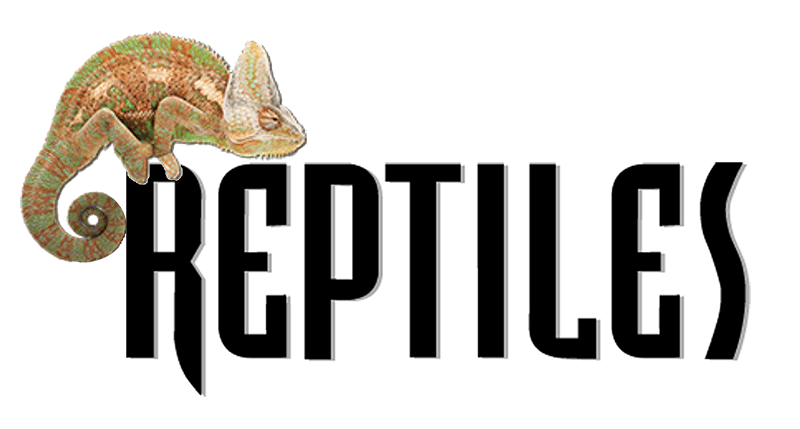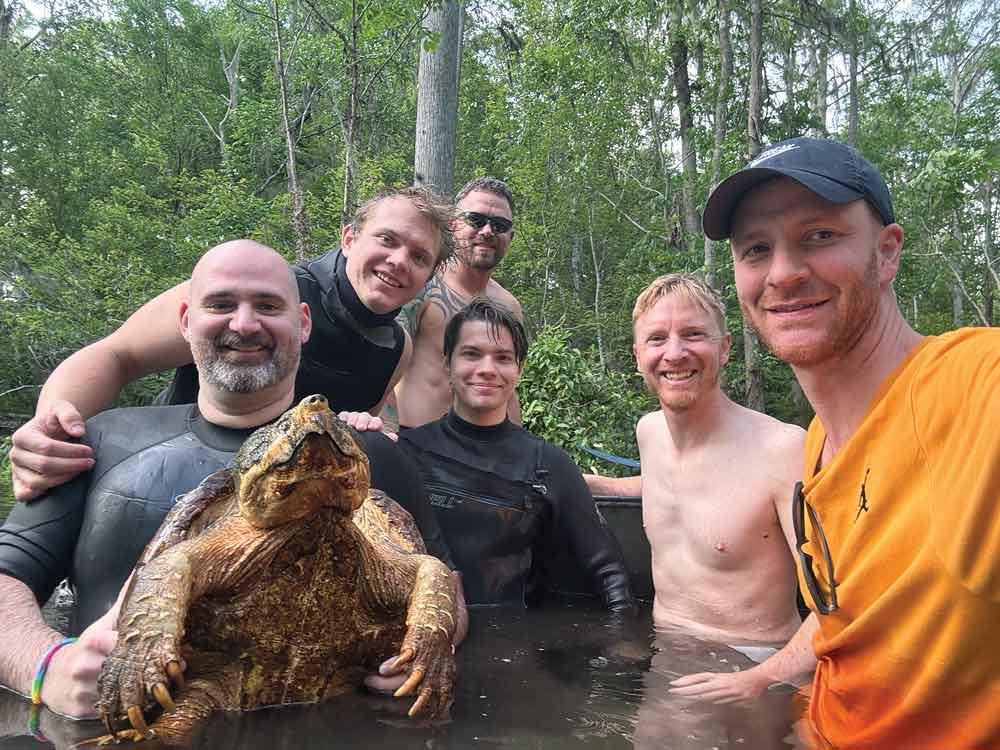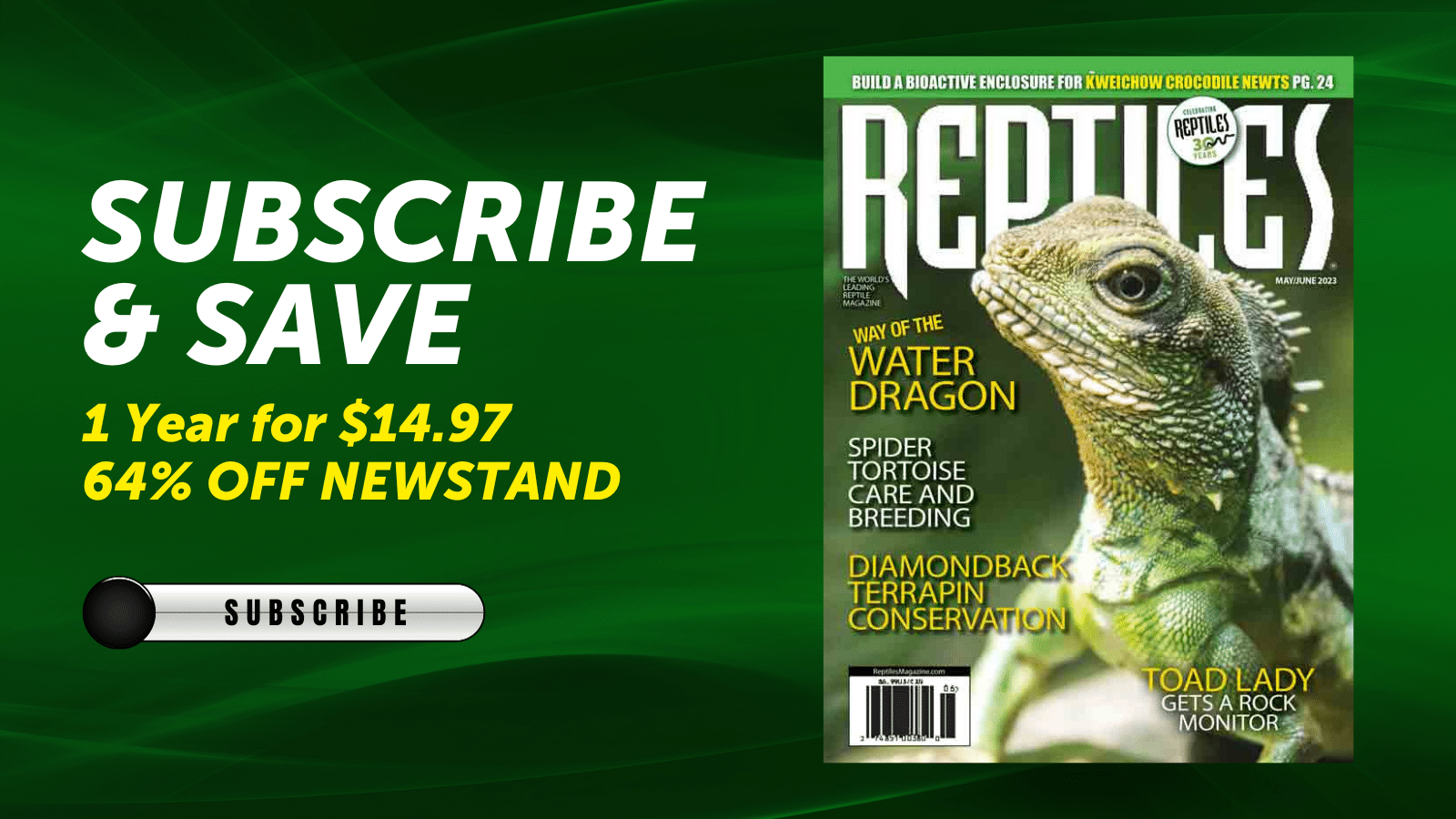Our plan was to cover the entire country, the long way, starting in Jacksonville, FL and spanning all the way to Los Angeles, CA. Route 10 covers that entire distance, but our goal would be to avoid that road at all costs. We would cover the entire country in only eight days.
Turtle Cannonball Run
It all started, as many things do these days, with a group text conversation. A few accomplished field herpers and I shared a dialog about what they thought would be a great opportunity to see the best of what the United States had to offer in terms of reptile diversity. At the time, I had been discussing some global travel options including Vietnam and China with a friend. The more I considered it, however, the more I realized that it was somewhat foolish to try to explore the world without experiencing the amazing biodiversity hotspot that is the southern United States.
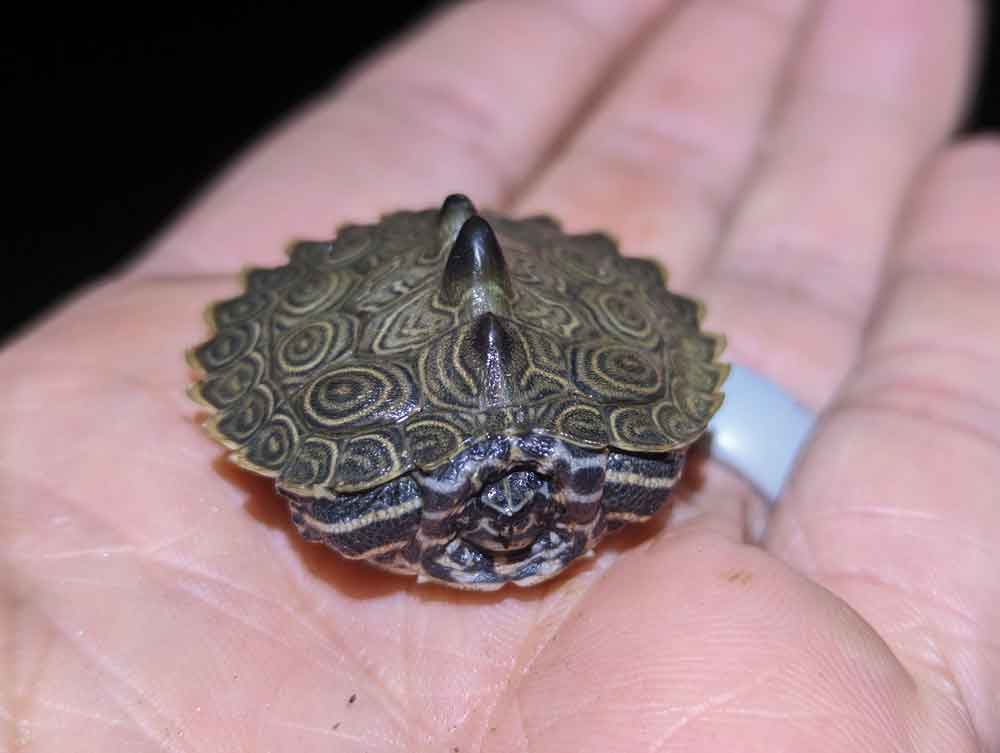
Black knob sawback turtle. Photos taken in Alabama by Anthony Pierlioni
The idea shared by my friends in the group chat was for a Turtle Cannonball Run, as we began calling it. None of them would end up joining me on the trip, but I took it to my friend Kevin Pollack (KP) and we almost immediately agreed that this was something we had to do. Our plan was to cover the entire country, the long way, starting in Jacksonville, FL and spanning all the way to Los Angeles, CA. Route 10 covers that entire distance, but our goal would be to avoid that road at all costs. We would cover the entire country in only eight days. We felt it was the perfect amount of time to really keep the pressure on. There would be a constant pressure to keep moving at nearly all times, juxtaposed by a need to stop and look for reptiles. This would create constant pressure that was sure to make for a memorable story.
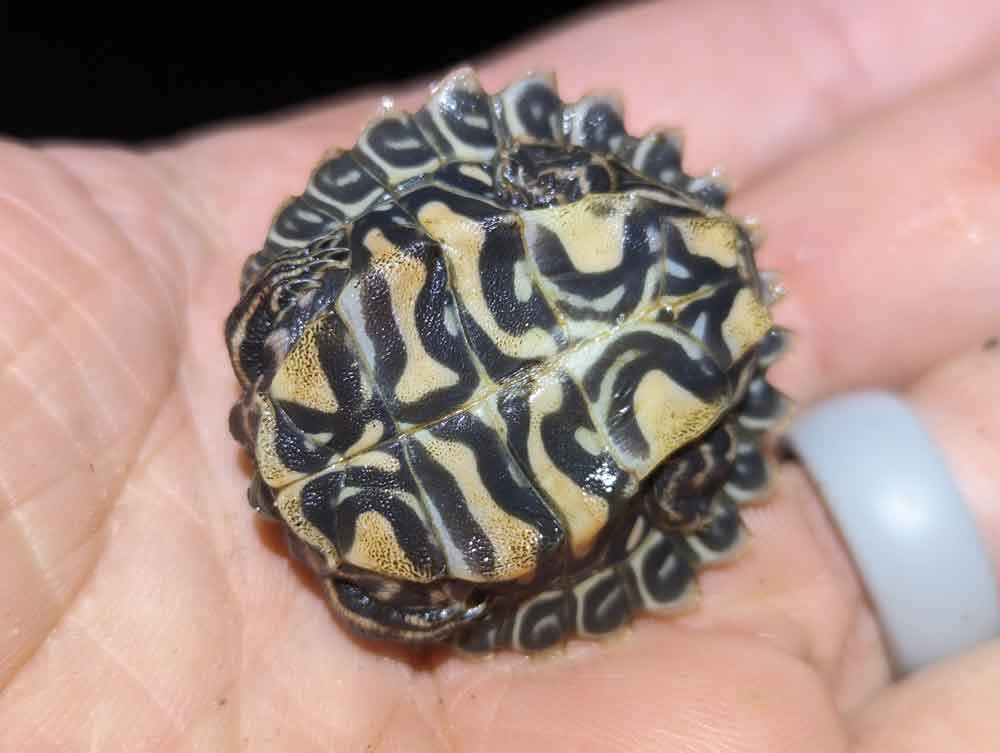
Black knob sawback turtle. Photos taken in Alabama by Anthony Pierlioni
KP is a talented, knowledgeable, and accomplished field herper, while I am more of a wildlife hype man who likes to visit experts in the field for a day or two at a time. This would be the biggest field herping undertaking of my life, and it wouldn’t even be close. We worked hard to identify people to potentially join us, and carefully curated that list and ultimately invited a few. The third and final person to join us on our journey would be my best friend and former college basketball teammate, John Weir. A very insightful human, John and I always had deep conversations about the natural world and the impact humans have on it.
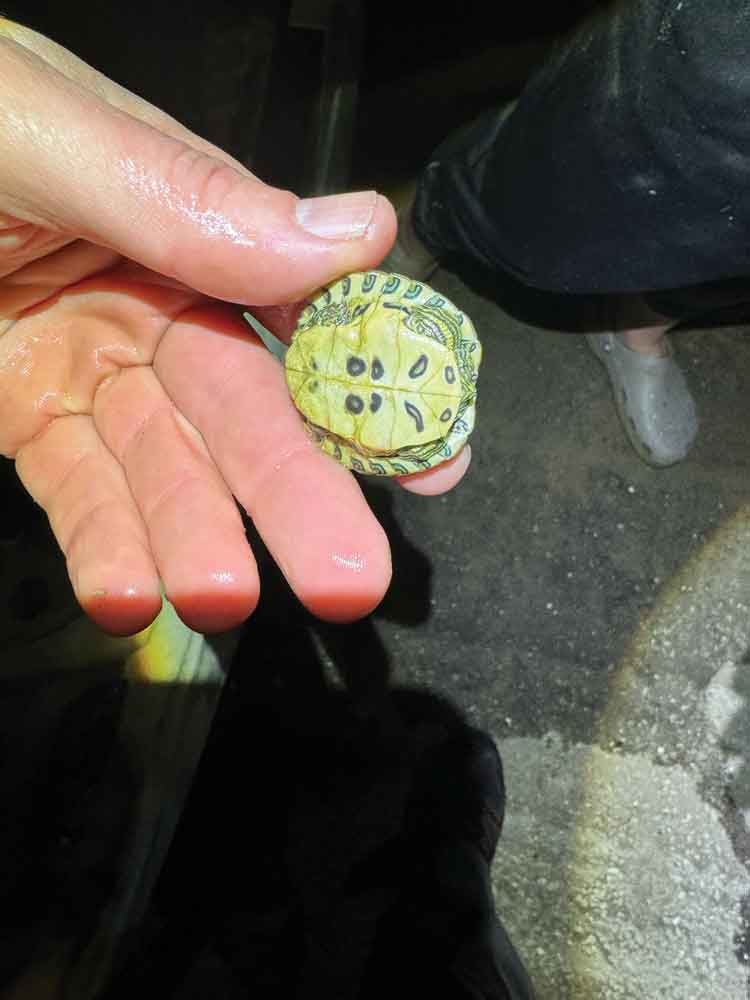
Cumberland slider. Photos taken in Alabama by Anthony Pierlioni
We’re Really Doin’ It
One of the first orders of business for us was to identify locations we wanted to visit, as well as species we wanted to prioritize. We needed to keep in mind that if we turned in one direction, prioritizing a species, we might be forfeiting our chances to see another. The same was true for continuing to drive across the country. Any progress we made meant we were leaving prime habitat for a species we had not yet, and likely wouldn’t, encounter.
We also made a list of over-under predictions for what we might encounter on the trip. Not being very accomplished betting men, the predictions did not end with the proverbial half point, which would help us avoid a push, where whatever we found had no chance of equaling our prediction. For a preliminary stab at this, we guessed that we were likely to find 13 different turtles, seven snakes, eight lizards, 10 frogs and toads, two salamanders, and one crocodilian.
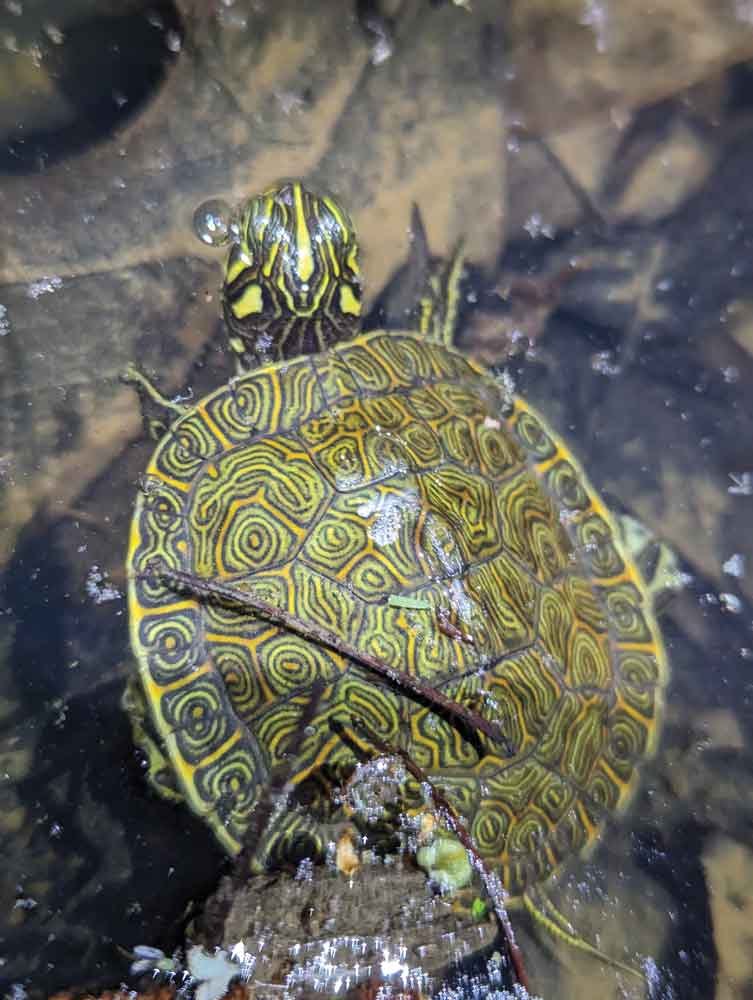
Eastern river cooter. Photos taken in Alabama by Anthony Pierlioni
We landed in Jacksonville and John was talking about road cruising. He had never done it before, but was already referring to the activity as his favorite part of the trip. On our first bit of cruising, we would find several snakes, including corn snakes, rat snakes and garter snakes. It was out trip to the springs however, that brought us what we were really after. We found 45 turtles in the short time we were there, including Suwanee River cooters, loggerhead musk turtles, and a species we were greatly hoping to see in the state of Florida, a gopher tortoise.
Babajaga
The real star of this trip was also found here though. I was busy swimming through the springs, which was not pretty. In fact, my efforts in the spring would be more appropriately described as narrowly escaping death by drowning. For one single moment, however, I was able to rise above my challenges and dive to grab what was my biggest hope for the trip.
A large, ancient Suwanee alligator snapping turtle (Macrochelys suwanniensis) was sitting on the bottom, trying to avoid detection. I grabbed her and lifted her out of the water, the team of field experts that joined us in the springs erupting with excitement. Jack Thompson, a college student and volunteer for the amazing Santa Fe River Turtle Project, was most excited. He had been to this spring around 60 times but had never seen this turtle.
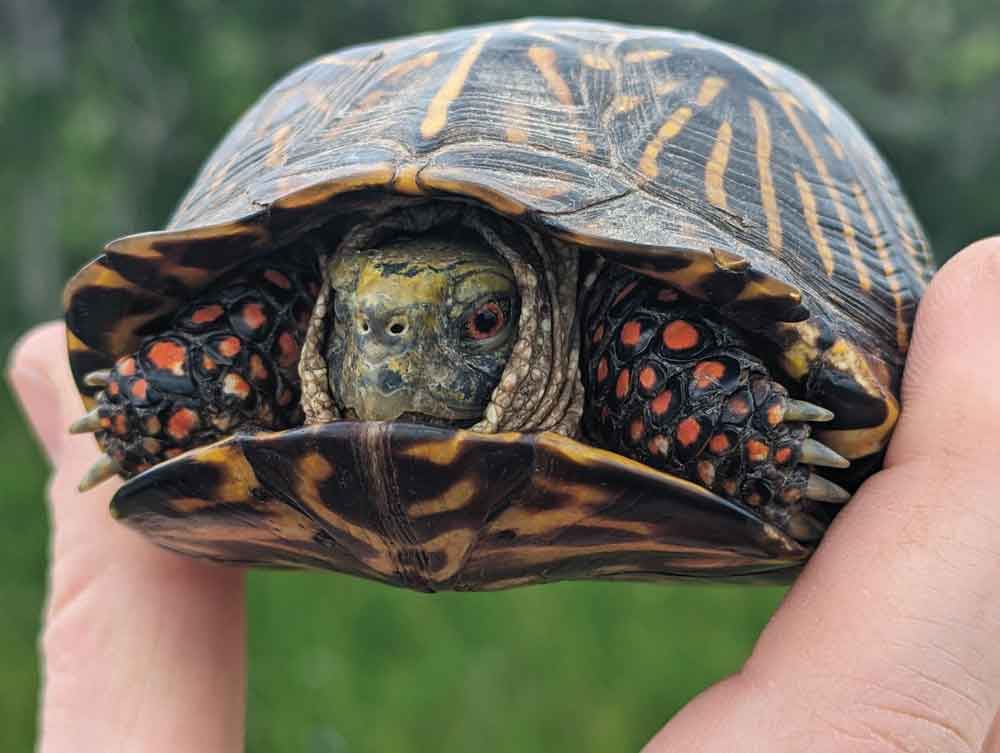
Ornate box turtle. Photo by Anthony Pierlioni
A true legend in this area, Babajaga, as she was known by the experts that lead research projects there, was as ancient as she was impressive. She was quite large for a female, the smaller of the two sexes in alligator snappers. She was blind, with cataracts in her eyes, which explained how I finally succeeded in catching a turtle that day.
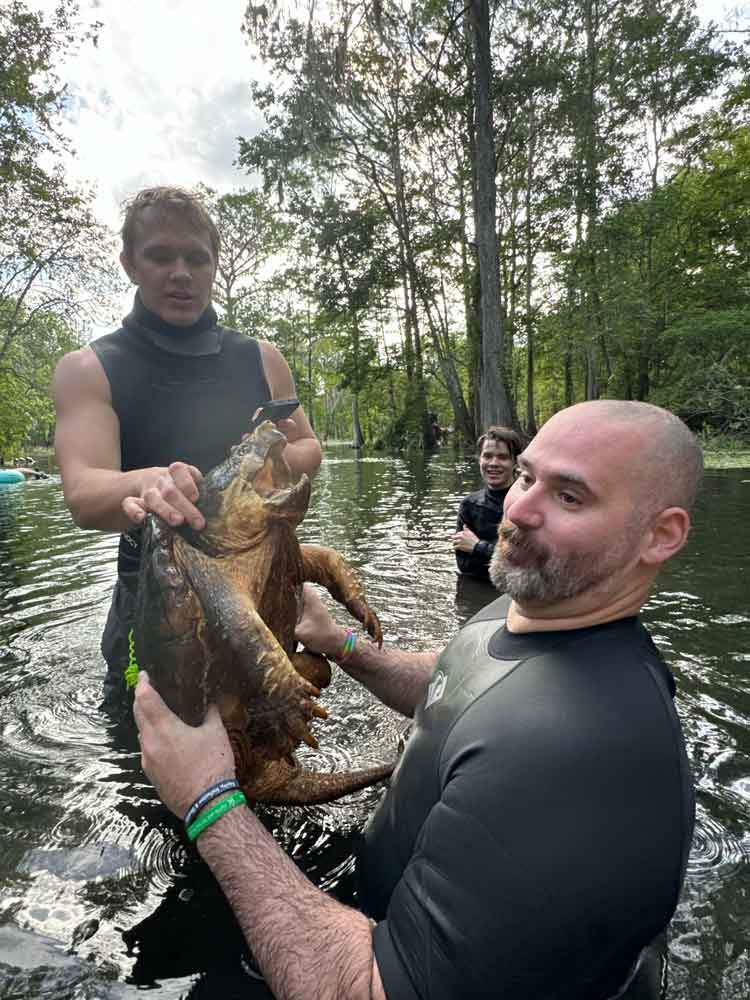
Jack and Anthony with Babajaga. Photo by John Weir
Florida Panhandle
The Florida Panhandle is well known among turtle experts for its diversity of species. There were two groups of animals we were most excited to see in that area. The first was the largest box turtle subspecies within North America, the Gulf Coast Box Turtle (Terrapene carolina major). They are known to have an especially striking phenotype in this area of the country, with males sporting white, yellow, and even blue coloration on their heads. While in the Apalachicola National Forest we saw a few that had been killed on the road. Just before we ended our time there, we found one animal that had not been hit. It was a great relief to leave the forest successful.
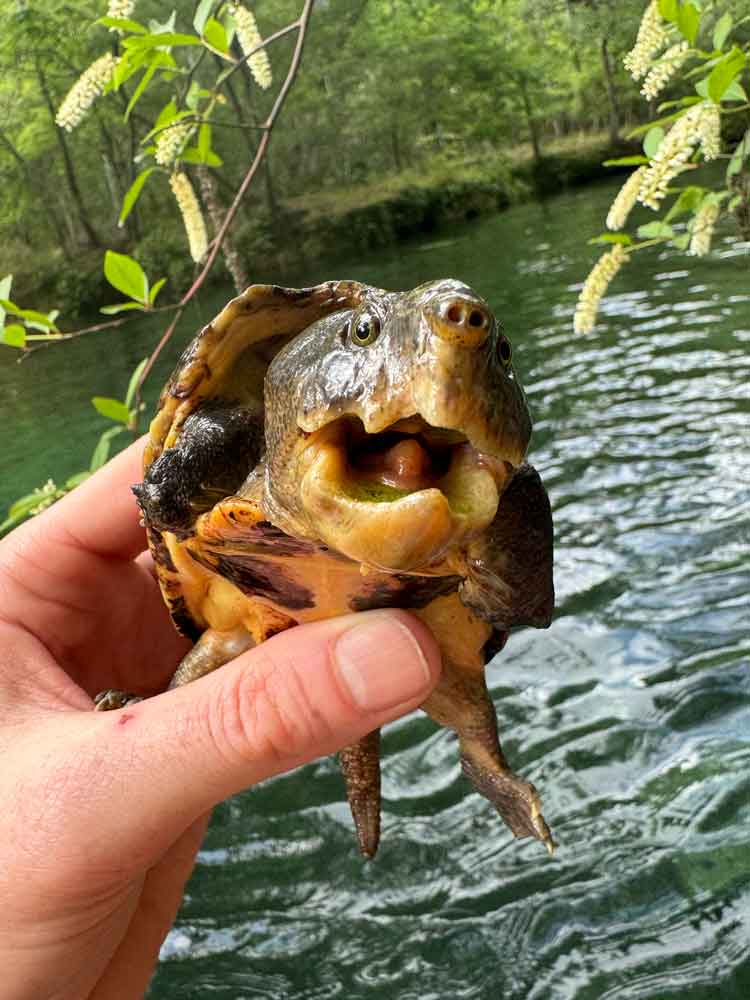
Loggerhead musk turtle. Photo by John Weir
We also saw Eastern mud turtles (Kinosternon subrubrum), which were out and about, much like the box turtles, thanks to recent rain that had made the dirt road we were traveling flooded and slick. Our rental van was covered in mud by the time we made it out of the forest. We also remarked a lot about how even in a national forest, man can have such a huge impact on the plants and animals found there. Habitat fragmentation, degradation, and elimination would be evident across the country, but this was the first time we were really seeing it.
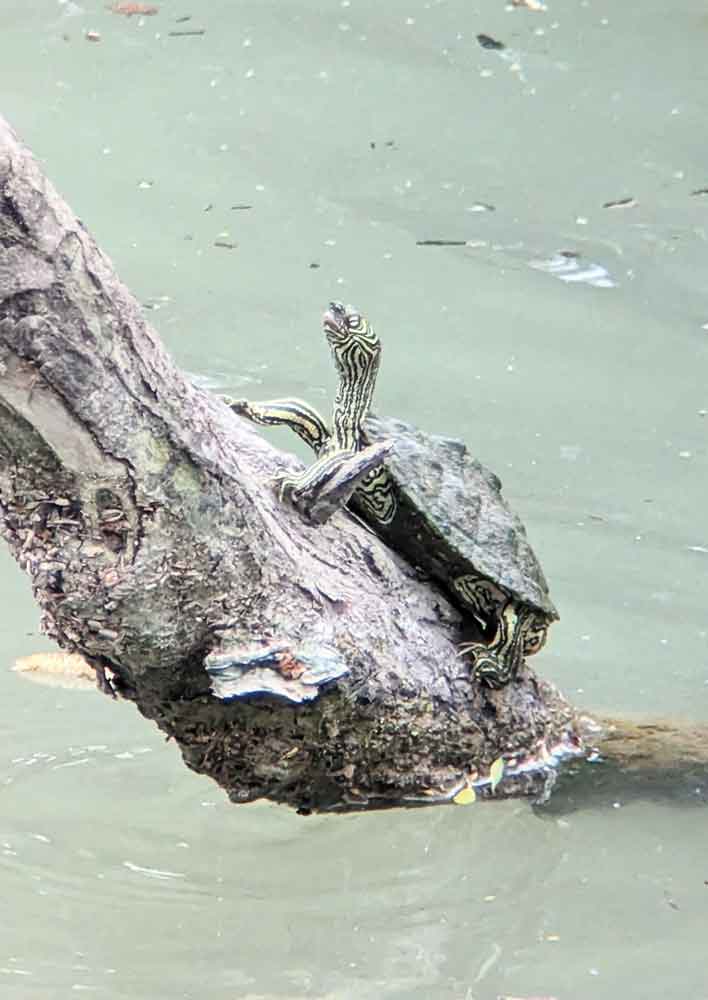
Cagle’s map turtle. Photo taken in Texas by Anthony Pierlioni
The next stop in the panhandle brought us something special in the form of three new turtle species. KP had purchased a new scope for this trip, which gave us the opportunity to view and even photograph basking turtles in tremendous detail. On a log we saw several new species all together, including Gulf Coast spiny softshell turtles (Apalone spinifera aspera) and Eastern River cooters (Pseudemys concinna concinna). The shining stars of that group of basking turtles in our eyes were the Barbour’s map turtles (Graptemys barbouri) we were seeing, especially a large female. These big girls are special because they become megacephalic as adults, largely due to their diet, which includes hard shelled mollusks.
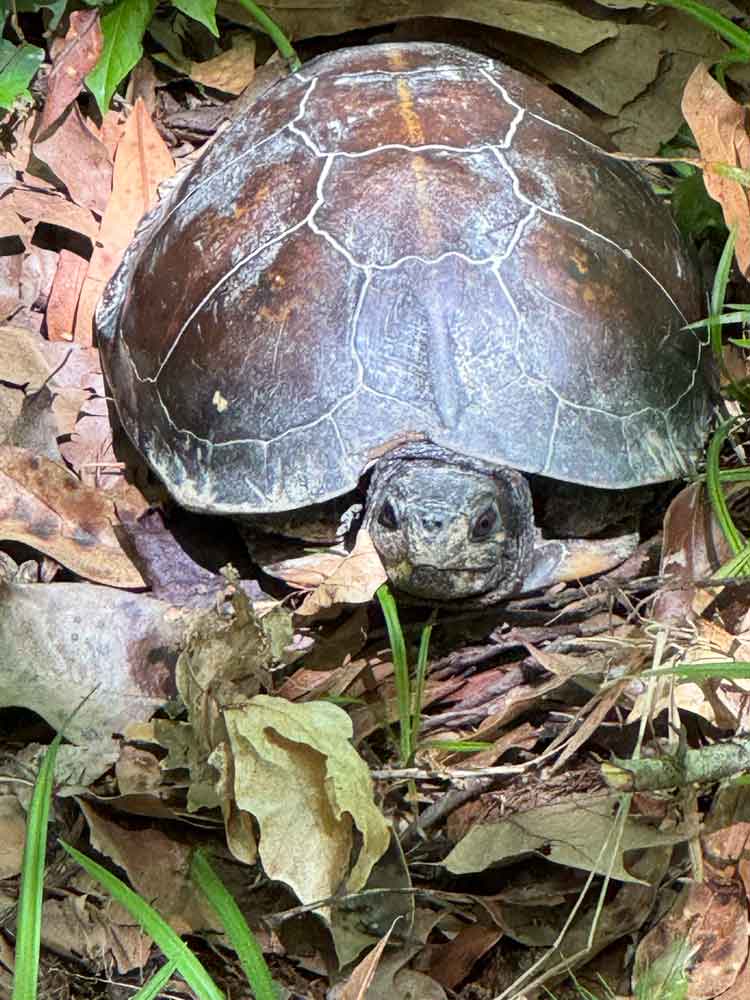
Gulf Coast box turtle photographed in Mississippi. Photo by John Weir
KP had many “herper rules” for what would and would not count as actual finds for our three-person team. If an animal was found by someone else just before we were there, that would not count as an encounter, for example. The scope would count, though, even if we were a bit far away from the animal(s) in question. Essentially, we would need to find it and be able to identify it, and it also had to be alive.
Turtle Blitz
Throughout the next several states, we would ride the high from what we had encountered in Florida. It started in Alabama, where we breezed into the state in a cliché way, blasting Lynyrd Skynyrd after dark. We decided to push on, which would prove to be a decision that would keep us out until around 4 a.m. and would lead to us spending the night in a Walmart parking lot. The things we do for reptiles.
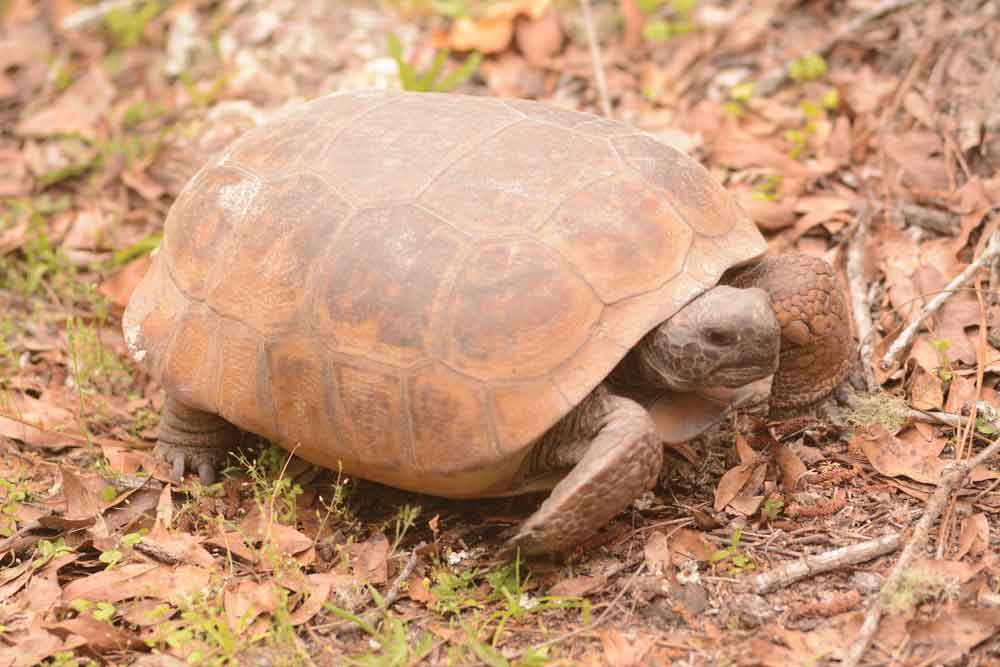
A gopher tortoise in Florida. Photo by Anthony Pierlioni
We were able to observe Escambia map turtles (Graptemys ernsti), black-knob sawbacks (Graptemys nigrinoda), intermediate musk turtles (Sternotherus intermedius), Cumberland sliders (Trachemys scripta troostii), and Alabama red-bellied cooters (Pseudemys alabamensis). Our heads were spinning. Seeing all of these animals in their natural habitat was incredible. The growing list of species encountered was enough to keep our energy up despite only sleeping a few hours in the last two days.
In Mississippi we kept adding to the totals. We started off finding a marbled salamander (Ambystoma opacum) and Fowler’s toad (Anaxyrus fowleri), but quickly got the turtle party started again with the finding of Pascagoula map turtles (Graptemys gibbonsi) and yellow-blotched map turtles (Graptemys flavimaculata). We leaped for joy every time we encountered a new species, but the main species we were looking for at that site had not yet been encountered.
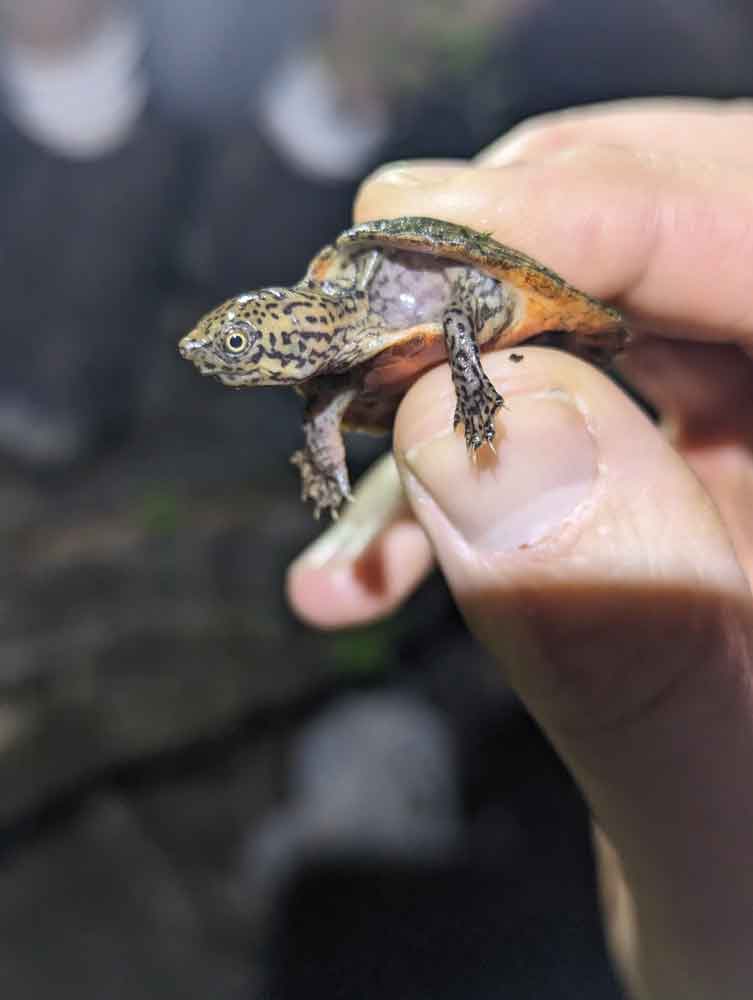
Intermediate musk turtle. Photo taken in Alabama by Anthony Pierlioni
The Pleistocene box turtle lived roughly 10,000 years ago. We had heard reports that the species may still be alive in a remote part of Mississippi, and recent literature suggests that the species still exists within living box turtles. More specifically, this ancestor of modern box turtles was thought to still live on today within Gulf Coast box turtles.
We looked and looked, and were ready to call it quits, being so exhausted from the days prior. Just then, we found them. Two adult male Gulf Coast box turtles that look entirely different than any we have seen. The animals have dark shells and skin, along with uniquely uniform markings.
We felt like we had found something really special, that perhaps was yet to be described and studied. In the future, we hope to help support work to look further into this.
Night Moves
Next up was the first location we would visit without the support of an outside expert that had personal knowledge of the sites. In other words, we were on our own. We made an executive decision to avoid New Orleans despite John’s desire to have a bowl of gumbo. We were heading north of the rest of our path, hoping we would make it to a special habitat in time to add another species to our list.
By the time we got there, shadows were extreme, which is not conducive to looking for basking species like the map turtles we were after. We needed to find the turtles before the sun set on our hopes. As we walked feverishly toward the river, we came upon a public beach with no one on it. An abandoned blanket and radio was playing. As we saw the turtles basking, Night Moves by Bob Seger began to play on the radio. It was a surreal moment. We were looking at ringed map turtles (Graptemys oculifera), my favorite species in the genus.
The Road to Buffalo Bayou
In Louisiana, we started to see less turtle diversity. We were, for the first time, seeing the infamous red-eared slider (Trachemys scripta elegans) in its natural habitat. I could not believe we made it this far across the country without seeing one. The entire state, being the swamp that it is, is a completely altered swamp. It seems that all water has been shaped by man to farm crayfish and serve other purposes. The manmade undertones do not waver as we enter Texas. Large fuel refineries and flaming towers extend from them as we enter the land of oil derricks.
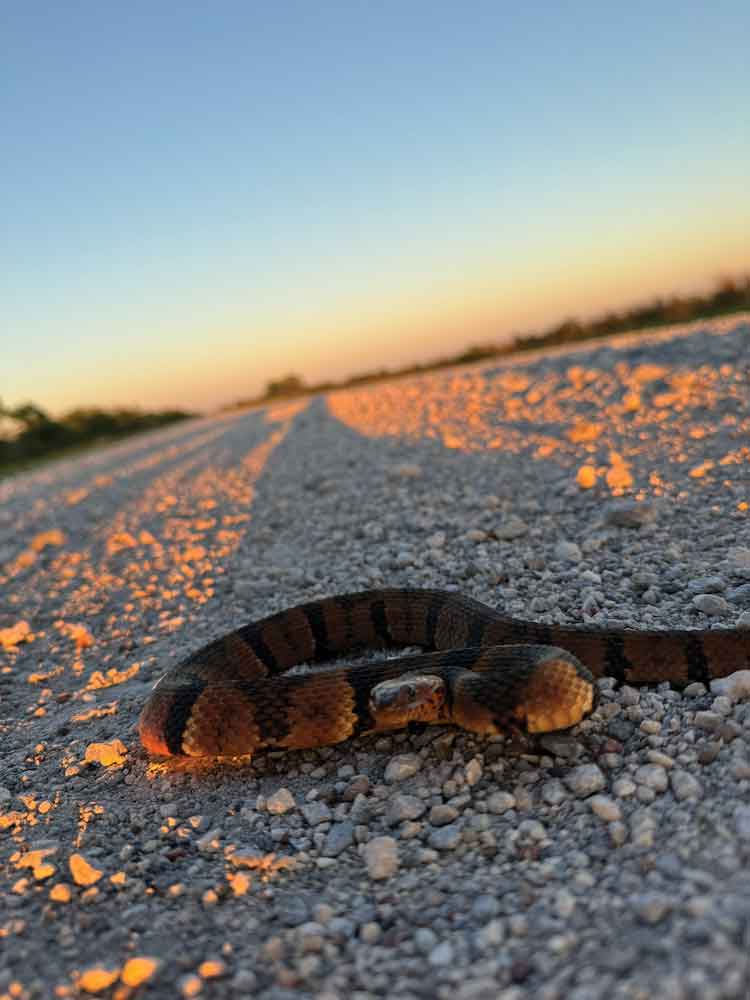
Texas water snake. Photo by Anthony Pierlioni
East Texas would prove to be more of a positive area for searching. We started finding an array of snakes, including a Dekay snake (Storeria dekayi), broad band water snakes (Nerodia sp.), Western rat snakes (Pantherophis obsoletus), and our first cottonmouth (Agkistrodon piscivorus) of the trip. We finally found our first bullfrog (Lithobates catesbeianus) and KP found a rough earth snake (Virginia striatula) while we stopped to gas up the van, which was already covered in dust. We had been road cruising with the side doors open, which made for a terrible environment for everyone’s lungs.
Next, we headed to Buffalo Bayou to meet researchers who had traps in the water. As long as we were there to check the traps, any finds would count, according to KP’s rules. The traps were not set correctly, so we did not find the alligator snapping turtles we had hoped for, but one trap did contain a large Pallid softshell turtle (Apalone spinifera pallida) that was beautifully colored. Eric Munscher, the head of the project, joked that the snappers here are likely some of the only turtles that you can say have eaten humans, given the amount of human bodies that end up in Buffalo Bayou, which runs through the city of Houston.
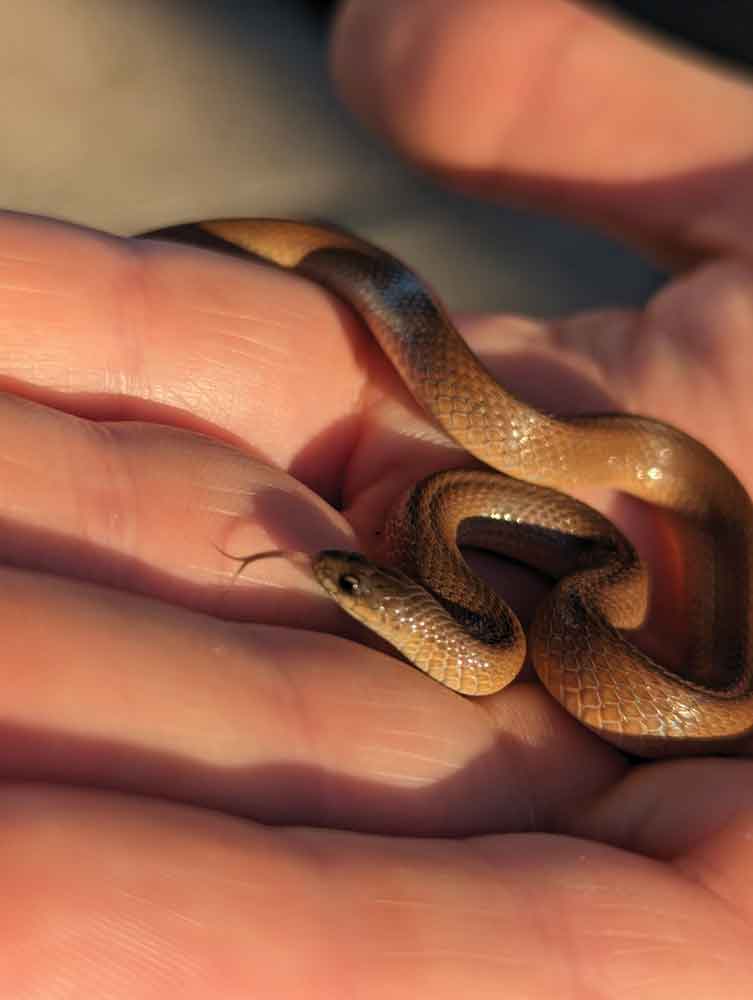
Rough earth snake in Texas. Photo by Anthony Pierlioni
Before reaching the center of Texas, where things turn into desert, we were able to encounter many more species, including Mississippi map turtles (Graptemys pseudogeographica kohnii), common snapping turtles (Chelydra serpentina), diamondback water snakes (Nerodia rhombifer), a stinkpot musk turtle (Sternotherus odoratus), an ornate box turtle (Terrapene ornata ornata), Texas cooters (Pseudemys texana), and an incredible Cagle’s map turtle (Graptemys caglei). Our hopes just kept on being fulfilled and we wondered how long this could continue.
Appreciate the Scenery
Once we hit the desert, everything changed. We were in prime country for finding snakes, but the time of year was wrong. Herein lies another main struggle for a trip like this. What is prime timing for one region is likely contraindicated for other regions. We found almost nothing through the western half of Texas. We decided we needed a win and prioritized a place in New Mexico where we felt we could make a real memory.

Road herping across the USA.
The decision was made to go for it, so we drove northwest to the Black River in search of a very special species for me. As a lifelong turtle keeper, I have worked with many species. I can still remember the first time I had a turtle shipped to me. It was a beautiful Rio Grande cooter (Pseudemys gorzugi) that I kept for many years. I told KP and John stories about that as we drove on bridges over “rivers” that had not a drop of water in them. When we reached the Black River, however, we found it.
KP asked, “Do sliders have red on their bridge?”
“They sure don’t!” I replied. There were several Rio Grande cooters basking on fallen logs.
The excitement of that find would be short lived and we would need to continue to appreciate the scenery as we found little through the state of Arizona. The total eclipse we had been hearing about all week was visible above us as we searched for mud turtles (Kinosternon sp.) in freezing cold water and desert tortoises (Gopherus sp.) on land. No such luck. We did find some new lizard species and a canyon tree frog (Dryophytes arenicolor). Arizona was the first state we visited where we had not found a turtle. The desert was not kind to us.
Dreams
We wrapped up our incredible journey across the country on day eight, with the eighth state we would encounter. We found a chuckwalla (Sauromalus sp.) at Joshua Tree National Park and a tremendously colored California kingsnake (Lampropeltis californiae) near a roadside canal. These two finds were important for us not only because they added new taxa to our list, but because they were new lifer species we had never seen in the wild. In fact, these were even lifer species for KP, who was visibly excited to have found them.
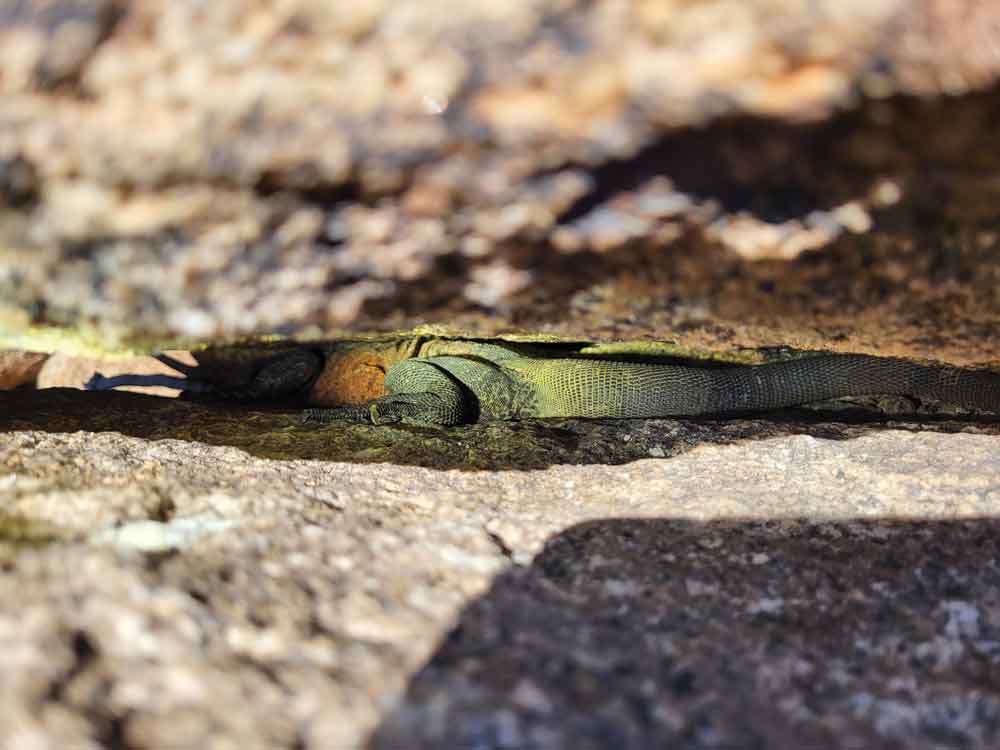
A chuckwalla wedged between some boulders. Photo taken in California by Kevin Pollack
One last site, after countless stops long the way, stood between us and a return home. This spot was one I had been to before, and was the type of place you might think up only in a dream. A concrete culvert along a homeless person camp, on the border of Los Angeles County, is one of the most surreal images you can imagine as a reptile lover.
The expansive culvert looks like the location where cars were raced in the movie Grease or where Arnold Schwarzenegger tried to outrun the T-1000 in Terminator 2: Judgment Day. A small amount , relative to the size of the concrete expanse, of water runs through into a manmade canal with boulders along its banks. Over a dozen shopping carts can be seen, scattered throughout the water.
Within the space, green sea turtles (Chelonia mydas) and red-eared sliders swim together, the latter representing a population of released pets. This unlikely scene, where these unlikely species seem to coexist well, at least upon surface level viewing, speaks to the adaptability of turtles. The sea turtles seem to be attracted to bright green sludge that runs down the culverts and into the canal, and the sliders are living there, in what must be brackish water, despite being a species adapted for life in freshwater.
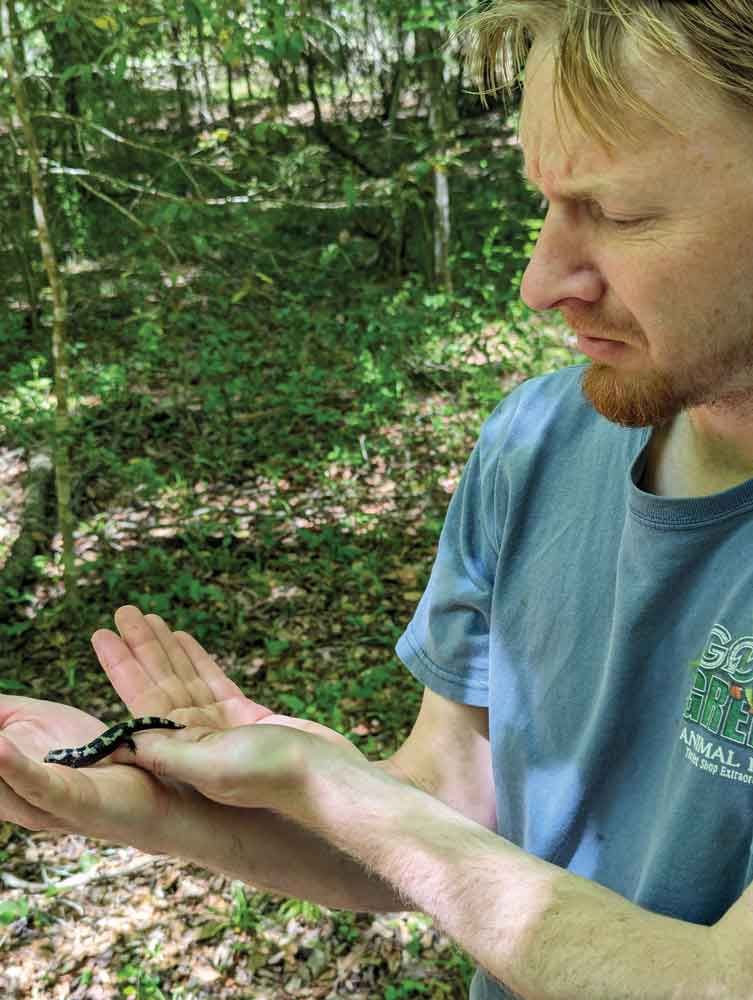
Kevin Pollack with a salamander
It seemed a fitting ending to an epic journey where we saw the impact that humans can have on the natural places the animals that we love call home. If we are going to continue to enjoy these animals that we love so much, we must do all that we can to protect them and their habitats. We set out to see some of the wildest swamps, bogs, bayous, rivers, prairies, and canals that the United States has to offer. Apart from one Native American reservation in Arizona, the entire landscape had been altered, some far more extensively than others.
We were not sure how our group would fare on this journey. Eight straight days of pressure filled travel is not for everyone. John and KP had never met before the trip, and I hoped they would get along. I think they liked each other more than either of them like me.
This positive interpersonal outcome was of course aided by the fact that we found animals – 413 in fact! We found 59 different herp taxa, including 27 turtles and tortoises, nine snakes, 10 lizards, two salamanders, and which should come as no surprise, one crocodilian. The only animals we did not meet our over-under for were frogs and toads. We found five.
Of all the animals we had found, 275 of them were turtles. That means that 67% of the animals we encountered were of the shelled variety. Our hope, is that we, as well as other herpers can take the precedent we set to try to beat our numbers for turtles and other herp species. That is, before we get out there and try it again ourselves.
Anthony Pierlioni is the Vice President of theTurtleRoom, an international turtle conservation organization. He keeps and breeds numerous endangered species of turtle and tortoise and works to educate the public about their plight. Anthony has written five books, one on veterinary leadership and four on turtles. His two most recent books are The Great American Turtle Chase and Turtle Preservation: The Ultimate Guide to Turtle Husbandry. Anthony’s YouTube Channel, Just Turtles, details his adventures as a turtle preservationist, conservationist, and advocate.You can order The Great American Turtle Chase on Amazon. https://shorturl.at/hnaUE
